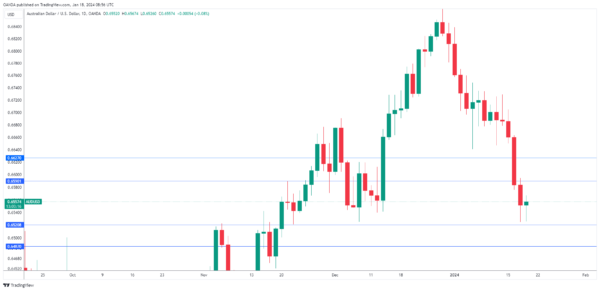The Australian dollar has stablilized after a nasty tumble this week. In the European session, AUD/USD is trading at 0.6555, up 0.06%. The Aussie ignored a weak employment report which showed job growth plunged by 65,100 in December. The unemployment rate remained steady at 3.9%.
Risk appetite, China weighing on Aussie
The US dollar looked dead in the water in the final two months of 2023 but has jumped out of the gates early in 2024. The Australian dollar has plunged 3.8% in January. Risk currencies like the Australian dollar have been hit hard, as nervous investors are showing less appetite for risk, for two main reasons.
First, the Federal Reserve remains cautious and continues to push back against market expectations for a rate cut in March. Fed members have dampened these expectations and signalled that the Fed is unlikely to cut in March.
Second, a batch of strong US data indicates that the US economy remains resilient, which means that the Fed is in no rush to start chopping rates. Fed Atlanta President Bostic said this week that there was the danger of inflation could “see-saw” if the Fed began lower rates too soon. The markets have responded by lowering their odds for a March rate cut. Just a few weeks ago, the probability of a March cut was above 80% but has dropped to 63%, according to CME’s FedWatch tool.
China’s economy continues to struggle and that is not good news for Australia. China is Australia’s largest trading partner and the Australian dollar is sensitive to Chinese releases. This was evident on Wednesday as soft Chinese data sent the Australian dollar lower to a five-week low.
China’s economy grew by 5.2% in the fourth quarter, a low rate of growth considering that the economy was expanding above 8% prior to the Covid pandemic in 2021. The real estate crisis continues to fester, weak domestic demand has resulted in deflation and the country’s population is decreasing. China is practically defined by its export sector, yet exports declined by 4.6% y/y in 2023, the first decline since 2016. The World Bank has projected that the economy will slow to 4.5% in 2024, pointing to further difficulties for the world’s second-largest economy.
AUD/USD Technical
- AUD/USD is putting pressure on support at 0.6520, which has held since mid-November. The next support level is at 0.6487
- There is resistance at 0.6590 and 0.6627













